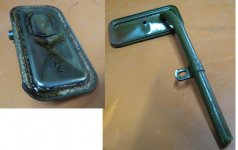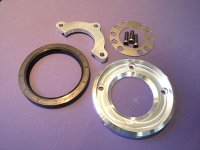This topic has probably been covered somewhere else so please direct me if you can.
Getting quite a bit of oil film/droplets underneath CW the 1098CG Sprite. The engine and g/box have recently been rebuilt and so I suspected need for retightening of sump bolts or similar, rather than failing seals. The bolts have been nipped up and happy they are not the source.
Appears to forward of the engine rear seal/'box front seal area. Local mechanic who knows A-series inside out (Mini specialist) suggested maybe the block side cover plate with the breather tube might be encouraging oil to flow down the tube due to a damaged/modified baffle. Here's a photo of it - I don't think his suggestion is likely given the how close the baffle is to the plate's inside surface. Is that the normal appearance of this part?

Other current suspects include the rocker cover oil filler cap and the little tube off the top of the rocker cover that is meant to go to the back of the air filter housing on the front carb. Its just open at the moment. Is positive crankcase pressure a possible factor bearing in mind engine is practically new? Oil pressure is consistent and strong.
I've also heard of oil-bearing fumes being a potential source if there is no oil scavenging - I have no PCV valves that I can see and its essentially an open system.
There's enough oil appearing to make it hard to just wipe off and then try and locate the source after a run.
Cheers
Getting quite a bit of oil film/droplets underneath CW the 1098CG Sprite. The engine and g/box have recently been rebuilt and so I suspected need for retightening of sump bolts or similar, rather than failing seals. The bolts have been nipped up and happy they are not the source.
Appears to forward of the engine rear seal/'box front seal area. Local mechanic who knows A-series inside out (Mini specialist) suggested maybe the block side cover plate with the breather tube might be encouraging oil to flow down the tube due to a damaged/modified baffle. Here's a photo of it - I don't think his suggestion is likely given the how close the baffle is to the plate's inside surface. Is that the normal appearance of this part?

Other current suspects include the rocker cover oil filler cap and the little tube off the top of the rocker cover that is meant to go to the back of the air filter housing on the front carb. Its just open at the moment. Is positive crankcase pressure a possible factor bearing in mind engine is practically new? Oil pressure is consistent and strong.
I've also heard of oil-bearing fumes being a potential source if there is no oil scavenging - I have no PCV valves that I can see and its essentially an open system.
There's enough oil appearing to make it hard to just wipe off and then try and locate the source after a run.
Cheers

 Hi Guest!
Hi Guest!

 smilie in place of the real @
smilie in place of the real @
 Pretty Please - add it to our Events forum(s) and add to the calendar! >>
Pretty Please - add it to our Events forum(s) and add to the calendar! >> 


